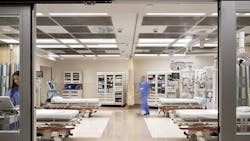Northwell Health launches program to improve care of patients with substance use disorder
Northwell Health announced a new “Pathways to Recovery” program in its emergency departments (EDs) in response to the opioid and substance use epidemic. Instead of simply reviving, stabilizing and discharging people who come in because of an overdose, the health system said in a news releases that clinical team members at Northwell’s 18 emergency departments will now provide a set of critical interventions that can could help patients find recovery support when they leave.
“Healthcare providers talk about the golden hour – the critical time after an accident or trauma when the right care can make all the difference,” said John D’Angelo, MD, senior vice president and executive director of the emergency medicine service line at Northwell Health, in the statement. “There’s a similar golden opportunity when someone comes into the emergency department for treatment of an overdose. Providing the services that are needed at that decisive moment is a key step in stemming the opioid epidemic.”
Northwell says The Pathways to Recovery program will roll out in phases to all Northwell’s 18 emergency departments.
The Pathways to Recovery program includes:
· Universal screening: Emergency department clinical teams use the Screening, Brief Intervention and Referral to Treatment (SBIRT) protocol with every willing patient who comes to an ED. SBIRT is a structured set of questions that helps healthcare professionals identify patients’ risk of substance use disorder, assess their readiness for change and, if willing, navigate them to treatment.
· Overdose prevention and protection: With Northwell’s NAL-SAT (naloxone saturation) campaign, healthcare professionals educate patients, and their families and friends, on how to prevent, recognize and respond to an opioid overdose. Those who are at high risk of experiencing or witnessing an overdose are also provided with a naloxone rescue kit, free of charge. (Kits are supplied through a partnership with New York State’s Department of Health.) Naloxone is a medication that rapidly reverses an overdose by knocking the opioid off its receptors in the brain. The rescue kits include nasal spray misters that automatically release the right dose of the antidote.
· Medications for addiction treatment (MAT): For some patients who are ready, the emergency department team initiates treatment with buprenorphine, an FDA-approved medication shown to aid in recovery from opioid use disorder by reducing symptoms of withdrawal and cutting cravings. Ongoing treatment with buprenorphine allows patients to benefit from counseling and behavioral therapies.
· Navigation to sustained care: For patients agreeable to addiction treatment, emergency departments will link them with an external “navigator” from Project Connect, a program developed in collaboration with Central Nassau Guidance & Counseling Services (CN Guidance) in Hicksville. These navigators come to the emergency department to support patients as they start on a pathway toward ongoing treatment, accompany them to treatment facilities and provide long-term navigation, advocacy and assistance. Having a relationship with a navigator can help patients who might otherwise fall through the cracks, finding it too difficult to connect to or continue with ongoing care.
· Streamlining transfer and stabilization: Some patients who require a bridge from the emergency department to longer-term care will be assisted through a collaboration between Northwell, the Nassau County District Attorney’s office and New Hope, an OASAS-licensed crisis stabilization center in Freeport. When patients need stabilization, short-term shelter, and navigation to further treatment, team members from New Hope are invited into the ED to meet them and transport them back to that specialized facility.
“When patients with heart disease or diabetes come to the emergency department, we don’t just treat their crisis and send them on their way – we offer options and connect them to the support they need to manage their condition. This program allows us to give patients with opioid use disorder that same level of care,” said Sandeep Kapoor, MD, director of Northwell’s SBIRT program.
SBIRT is in use in 14 of 18 EDs departments, and NAL-SAT has been implemented in 16, including the pediatric ED at Cohen Children’s Medical Center in New Hyde Park. Team members using SBIRT have screened more than 765,000 people at Northwell EDs and have dispensed 3,246 rescue kits via NAL-SAT. Medication for addiction treatment is available at four EDs and has been provided to nearly 40 patients since that initiative was piloted last July.
Project Connect launched last year and has assisted 230 patients from three EDs. In March, Northwell and CN Guidance were awarded a $350,000 grant from New York State Office of Alcoholism and Substance Abuse Services to support their ED-based MAT initiation and external navigation services.





